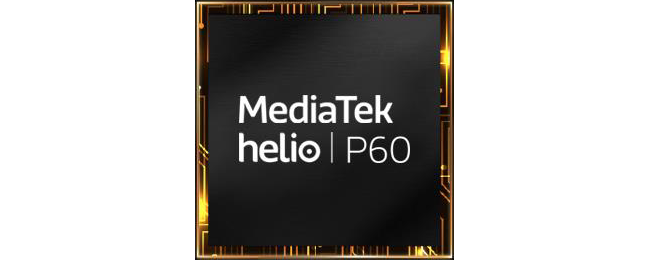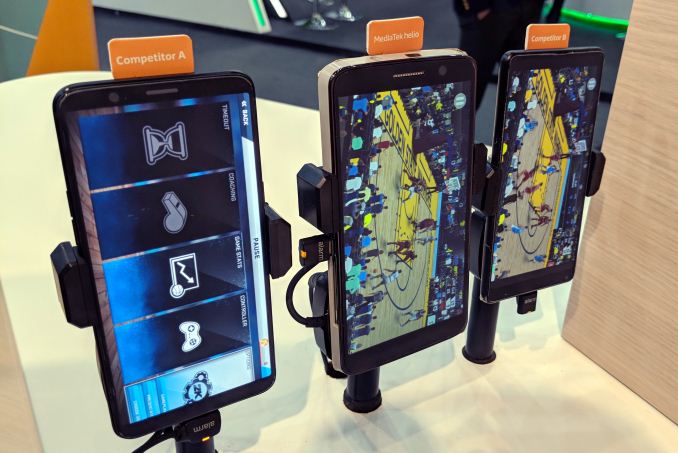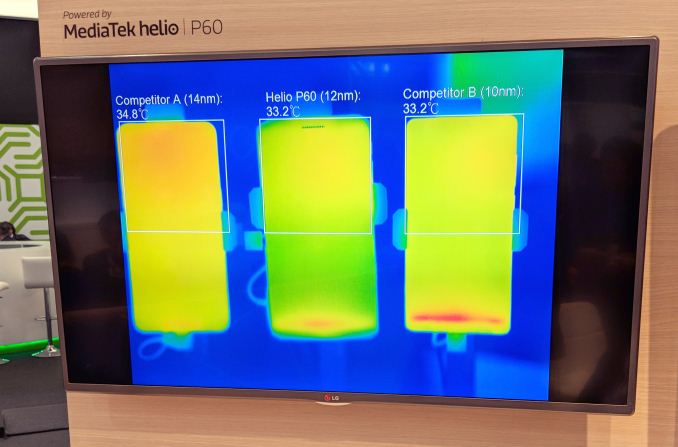MediaTek Announces New Premium Helio P60 SoC
by Andrei Frumusanu on March 1, 2018 9:30 AM EST- Posted in
- Smartphones
- Arm
- Mobile
- Trade Shows
- MediaTek
- Mali
- Helio
- MWC 2018
- P60
- A73
- A53
- ARM Cortex

BARCELONA, ESP – Earlier this week MediaTek announced a new entry in the Helio SoC line-up, the Helio P60. The P60 comes with a strategy change for MediaTek as the company is doubling down on the super-midrange “premium” category and expanding that range into multiple sub-tiers.
The strategy change comes from market and lack of success in the high-end Helio X series. Last year’s Helio X30 had only a few design wins and was relatively late to market. MediaTek seems to have had a string of bad luck with the X20 and X30 as both came on either problematic or very delayed manufacturing process nodes which lost them important design wins. As more vendors switch over to custom designs in the high-end and Qualcomm puts more pressure with competitive designs, MediaTek decided to put a hold on the X series for now and concentrate in the range where it is very successful, the P series.
The this new segmentation means that the P60 doesn’t position itself as direct successor to late last year’s P23 and P30 but rather as a tier above them, hence the naming scheme.
| MediaTek Current P-Series | |||
| SoC | Helio P23 | Helio P30 | Helio P60 |
| CPU | 4x Cortex A53 @ 2.3GHz 4x Cortex A53 @ 1.65GHz |
4x Cortex A53 @ 2.3GHz 4x Cortex A53 @ 1.65GHz |
4x Cortex A73 @ 2.0GHz 4x Cortex A53 @ 2.0GHz |
| GPU | Mali G71MP2 @ 770MHz | Mali G71MP2 @ 900MHz | Mali G72MP3 @ 800MHz |
| APU / NPU / AI Proc. / Neural IP | - | 2x 140GMACs | |
| Memory | 1x 32bit LPDDR3 @ 933MHz 2x 16bit LPDDR4X @1500MHz |
2x 16bit LPDDR4X @ 1600MHz | 1x 32bit LPDDR3 @ 933MHz 2x 16bit LPDDR4X @ 1800MHz |
| ISP/Camera | 1x 24MP or 2x 13MP | 1x 25 MP or 2x 16MP | 1x 32MP or 2x 20+16MP |
| Encode/ Decode |
2160p30 H.264 | 2160p30 H.264 & HEVC | 2160p30 H.264 & HEVC |
| Integrated Modem | Category 6 DL = 300Mbps 3x20MHz CA, 64-QAM UL = 50Mbps 64-QAM |
Category 7/13 DL = 300Mbps 3x20MHz CA, 64-QAM UL = 150Mbps 2x20MHz CA,64-QAM |
Category 7/13 DL = 300Mbps 3x20MHz CA, 64-QAM UL = 150Mbps 2x20MHz CA,64-QAM |
| Mfc. Process | 16FFC | 16FFC | 12FFC |
The P60 is the first SoC in the P-lineup to employ “big” microarchitecture cores as it uses 4x Cortex A73 cores at up to 2.0GHz – a significant performance boost in performance over the P23 and P30’s A53 cores. The efficiency cores are naturally still Cortex A53’s and they run at the same 2.0GHz frequency as the performance cluster.
On the GPU side we see an update in the IP as MediaTek in turn transitions from G71 to G72. The P60 uses a G72MP3 running at up to 800MHz and promises a 25% gaming efficiency boost (at up to 70% higher GPU performance).


Snapdragon 660 vs Helio P60 vs Snapdragon 835 Thermal Comparison @ MWC2018
The P60 is the first mobile SoC to come manufactured on TSMC’s new 12nm 12FFC process node. 12FFC is a shrink of 16FFC and uses the same tools – it’s a cost effective alternative to the more expensive 10FF process which requires quad-patterning. While 12FFC does not quite achieve the die size reduction that 10FF would, it’s extremely competitive in terms of power characteristics and reaches near the same efficiency. I asked MediaTek about the company process roadmap plan and they will focus exclusively on 12FFC for 2018 and have no plans for further 10nm silicon. The next generation will jump directly to 7nm in mid 2019 (after other vendors) when mass production will have reached mature and cost-effective levels.
The P60 is the first SoC to bring dedicated neural network accelerators into the mid-range. MediaTek’s denomination for such IP is APU (AI Processing Unit) so that’s yet another term added to the varied basket of abbreviations from different companies. MediaTek wouldn’t disclose the IP provider but say’s it’s a dual-core implementation offering 2x140GMACs. MediaTek will offer a custom software stack called NeuroPilot which will be compatible with Google’s NN API and frameworks such as TensorFlow, TF Lite, Caffe and Caffe2.
The modem subsystem remains the same as on the Helio P30 – it supports LTE up to Category 7 with 3x20MHz CA and 300Mbps download speeds and Category 13 with 2x20MHz CA for up to 150Mbps upload speeds.
The Helio P60 is in production now and we should see consumer smartphones with the chipset available starting early Q2 2018.










74 Comments
View All Comments
jjj - Sunday, March 4, 2018 - link
If true it suggests it's a solution focused on costs. If there is a P40, they could go as low as 12$ with it, then this one at 15-18$ and they likely have a significant cost advantage over SD636 and SD660 so they would win share. A73 and 12nm makes sense in this context (cost focus) , time to market ,lower dev costs, smaller die (vs A75) and so on. But then, what is P70 and is it a different die.P70 might have a more difficult time vs SD640 and SD670- assuming this is the SD7xx series- but they would grab good share with the P40 and P60. So they address the 10-20$ price bands very well and P70 tries to get some wins above.Hopefully DRAM prices don't go above 10$ per GB this year, not that 10$ isn't already stupid high.
ZolaIII - Sunday, March 4, 2018 - link
We can only speculate about P70 & what will be a S7xx which isn't exactly the most great full thing to do. Earlier P leak:https://www.gizmochina.com/wp-content/uploads/2017...
& what should be a S7xx:
https://www.gizmochina.com/wp-content/uploads/2017...
Seams P40 turns out to be a P60 while S640 is actually S670 at least now. S7xx isn't there to address the P series it's there to address the most unsuccessful MTK chip the X30 which they sell now for future discounted prices as they had a bulk of it & didn't really know what to do with it.
Well 10$ is double the price of what it used to cost last time we discussed about DRAM prices.
jjj - Sunday, March 4, 2018 - link
DRAM was getting to 3$ in 2016.P70 is either this same die and then this P60 die likely has a Mali MP4 and a modem that can do better but that does not help costs, or P70 is a different die and then... we'll see.
The SD670 is likely to be 4xA75 @ 2Ghz or higher (the leaks vary with some at 2GHz , others at 2.6GHz) while the 640 should be same die with large chunks disabled- 2 big cores, memory controller, GPU. Some leaks also claim more SKUs but all these leaks are from China and most are 100% fabulation.
The SD636 is clearly just a SD660 lite so not ideal from a cost perspective as that die wasn't aimed at lowest costs, or power for that matter.
The P40 (it it exists as a P60 at slightly lower clocks) and the P60, seem to be aimed to replace the octa A53 SoCs in the 10 to 20$ range, so we finally got to this point and that should be the headline here. 8xA53 are relegated to bellow 10$ and these new SoCs give us quite a lot more.
SD670 ,likely legit https://browser.geekbench.com/v4/cpu/6133079
jjj - Sunday, March 4, 2018 - link
* I suppose, SD670 could be 2xA75 and 6 small cores.Wardrive86 - Sunday, March 4, 2018 - link
While I agree with what most of you are saying, when you buy a Mediatek chip and can play fewer mainstream games... because only Chinese developers support it and few elsewhere, and have terrible drivers, terrible battery life, and extreme throttling compared to Qualcomm, then there is no competition . You say the 845 is terrible when it literally loses in one synthetic benchmark...though it will be used in literally every flagship not just because of baseband but also because, more than likely, it will have little to no competition in the high end. Qualcomm equals universal app support, great efficiency, great performance at all price segments...currently...yes there has been mistakes but they are much more consistent than their rivals ....including Samsung. In my experience when you buy a cheap Chinese SoC once, because of app incompatibility, battery life, etc. You will never buy one again.serendip - Monday, March 5, 2018 - link
Mediatek could put up real competition to Qualcomm if it can close the efficiency gap. I don't game so the lack of GPU performance doesn't bother me, but a SoC needs to be snappy (hehe) and efficient. Mediatek has to stop looking at benchmarks only.See the Redmi Note 3 X10 vs. SD650 and Note 4 X20 vs. SD625 comparisons. The Mediatek SoCs have comparable performance but efficiency is way behind, even when using the same components.
ZolaIII - Monday, March 5, 2018 - link
Not a fair comparison... S650 vs X20 it's a more realistic one but we are bean there & done that.I did a lot of; study, reading and finally writing for the script that makes the most in power/performance/snappines for S650/650 trough standard in kernel mechanisms (scheduler, HPM scheduler & in built (now module) corectl hotplug. While writing it whose not that hard making it work as it should gave me much headaches as there is still a design flow in A53's that makes IRQ's & other near real time tasks to fall upon migration while this is present & without use of hotplug, with it it really cased a lot of problems like networking stalls and crashes. Their isn't a fix for it but we used workaround to run those tasks as RT one's & it's all good that way. Then there ware problems & in scheduling code which we addressed true mainline backports. At the end biggest problem ware users as they did to to the separate
ZolaIII - Monday, March 5, 2018 - link
Extremes. From extreme power savings to best possible peak performance. It whose very hard to make up for those antagonisms. That part I did with default not used HPM sched "heavy parts" smoothing migration transitions & allowing short bursts up to max frequency... End result whose a 20% better SOT while retaining rather good user experience, tho not everyone whose satisfied nor will ever be. Thing is if you have a code to work with you can change vendors benchmarking related advertising garbage behaviour & gain a lot on user experience and usability but it's do it yourself & will remain so.ZolaIII - Monday, March 5, 2018 - link
"heavy tasks" *ZolaIII - Monday, March 5, 2018 - link
It's concerning that S845 pushes CPU clock rates so much higher than the S835 while new core's use more power & certainly switch from 10nm Early to 10nm Performance isn't capable to compensate so S845 will be almost two times less efficient than S635 in heavy CPU tasks. On the GPU side as you could read hire it drives almost a W more of power & will throttle significantly. If the S7xx (announced before as as S670) turns out to be as hoped it will represent much better choice as it will be able to sustain two big cores @2 GHz & all 4 at 1.6GHz (same as S845) GPU & Memory will be cut off 25% but will also be able to sustain near maximum performance in prolonged use while S845 will throttle down to the almost same level (will remain only cuple procenta faster thanks to 4x16 LPXDDR vs 3x16 LPXDDR). I don't even want to talk about SoC's with MALI graphics.You ain't buying cheap Chinese SoC yet MTK is Taiwanese & HiSilicon isn't cheap nor available to other vendors. Things will hopefully improve on drivers front as that is the main purpose of project Treble.